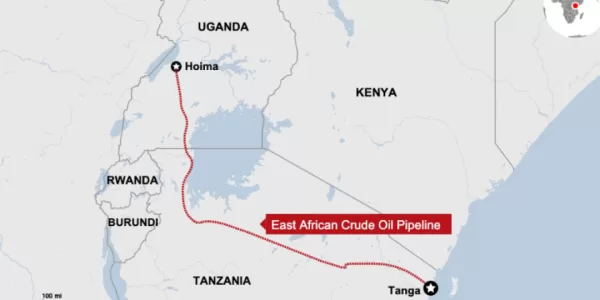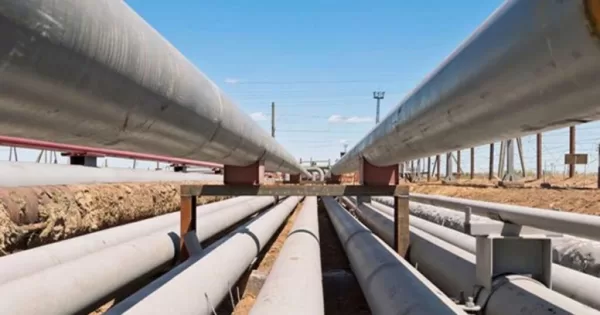Updated September 2, 2025: The world’s longest heated oil pipeline has achieved a significant milestone as it hits 64.5% completion. Uganda and Tanzania have shown zealous commitment in seeing the project through as it gradually takes shape. Stretching 1,443 kilometers, it is the world’s longest heated crude oil pipeline and is designed to transport Uganda’s crude from Kabaale-Hoima in western Uganda to the Chongoleani Peninsula near Tanzania’s Tanga Port. Once complete, it is expected to be elemental in East Africa’s energy strategy. Moreover, it will greatly facilitate regional economic co-operation and transformation. The heating system prevents the waxy Ugandan crude from solidifying. On the other hand, the fiber-optic network along the pipeline will supports real-time satellite monitoring and leak detection to mitigate environmental risks.
November 15, 2023: The government of Uganda, through its minister of energy, Ruth Nankabirwa, has provided recent insights on its ambitions regarding the world’s longest heated oil pipeline. The country has noted that it targets 2027 as the expected timeline to ensure the project is operational. Furthermore, the nation notes that the pipeline is still in the works and will be operational by then. This is despite the financial delays that have been witnessed, blamed on activists’ protest that impede the project. Uganda’s government has defended itself, noting that their aim to ensure the country’s development of fossil fuels.
“The East African crude oil pipeline is ongoing. We have invested a lot of money in exploring exploration and in critical infrastructure. We are now drilling,” noted Nankabirwa at the COP29 climate summit in Azerbaijan. Aiming to enhance its energy industry, Uganda focuses on being able to export oil from two oilfields. The pipeline is expected to run through Tanzania to the port of Tanga as construction is already underway. Once complete, the project will facilitate in enhancing oil production. Moreover, Uganda and Tanzania show Africa’s zeal to improve oil production. Similar projects in neighboring countries such as Congo’s Republic offshore exploration in Nzombo area by TotalEnergies also highlight this commitment.
Project Factsheet
Location: East Africa
Capacity: 230,000 barrels a day
Significance: World’s Longest Heated Oil Pipeline Project
Length: 1,443 Kilometers
Project duration: 3 years
Project Cost: $5 Billion
The Significance of the World’s Longest Heated Oil Pipeline in East Africa
The significance of the world’s longest heated oil pipeline in East Africa is expected to be unprecedented. Once completed, it is expected to transform East Africa’s energy market, especially Uganda. However, it has been criticized for displacing communities and damaging the environment. Nonetheless, the nation promises that the pipeline is focused on ensuring sustainability and minimal disruptions. It also asserts that once the pipeline is operational, Uganda expects to produce 230,000 barrels a day of oil. This feat is in production surpasses that of Gabon, currently an OPEC member.

Of these, 60,000 barrels a day will be refined for domestic use while the others will be exported through the pipeline. Employing innovative means, the pipeline will be electrically heated to help pump Uganda’s viscous crude grades. The oil discovered near the Albertine rift basin near the Democratic Republic of Congo has been a source of hope for the nation. President Yoweri Museveni is hopeful that it will elevate the country to a better status, economically.
The State of Affairs Regarding the East Africa Crude Oil Pipeline
Many African countries face the conundrum whether to focus on fossil fuel investments in times of diverse climate change. However, the world’s longest heated oil pipeline is one that Uganda is focused to ensuring is viable. “Developing countries that have good deposits are seeing that as an opportunity. Once exploited, to get money for social and economic development,” said Nankabirwa, Uganda’s minister of energy. The endeavor is expected to cross nature reserves along the basin of Lake Victoria, Africa’s largest. This is expected to displace many communities and wildlife across Uganda and its neighbor, Tanzania. Because of this, many activists are skeptical about the how the project will benefit locals. Organizations have held protests against the project but ignored by the government.

The energy minister stifled this criticism as she noted that activists fail to appreciate and embrace the future. She noted that they fail to see the bigger picture and spread rumors on the impact of the project. “They have told lies that we have displaced animals and people,” she said. East Africa, especially Uganda remains optimistic that the project will push through. They also hope that it will be a success, and operate for 25 years as noted by the minister. The construction works for the establishment of the main camps by TotalEnergies, the terminal for storage, and the pipe yard are progressing at the pump station one located in Hoima District in Nyamasoga area, Kasamya area located in Kakumiro District and also in Ssembabule District.
Also read: Tanzania- Uganda Gas Pipeline Project Feasability Studies to Commence
East African Crude Oil Pipeline Construction Process
On matters concerning land acquisition for the world’s longest heated pipeline, the communication lead of the pipeline project noted that they are handling the cases at hand. He also noted that they will be issuing the warning letters before the commencement of the construction of the pipeline route to the individuals whose lands were affected but have still been holding onto and using the projects land. Like the feeder oil pipelines of Tilenga and Kingfisher, the East Africa Crude Oil Pipeline will first have to undergo stringing and also welding before it gets buried under the ground.
After, the signing of the Final Investment Decision (FID) between the two countries i.e. Tanzania and Uganda and the oil companies that will be a part of the project; the activities of acquiring land for the project, compensation of those affected by the project, building replacement houses for the people that will be affected by the project, restoration of the livelihood of the people affected and also the procuring of the construction materials of the EACOP kicked off.
Also read:

